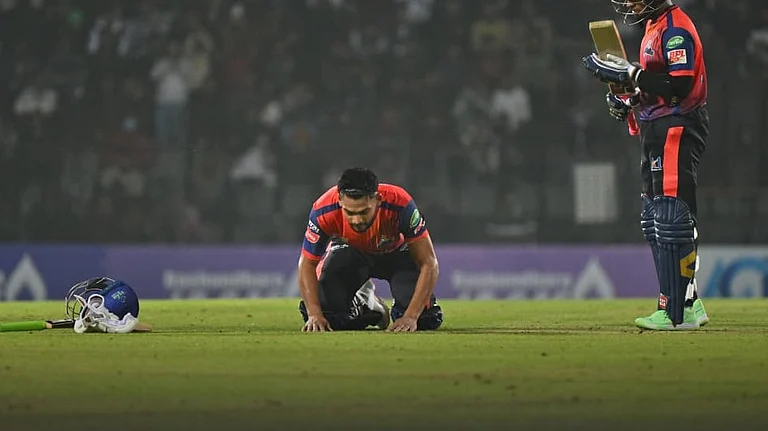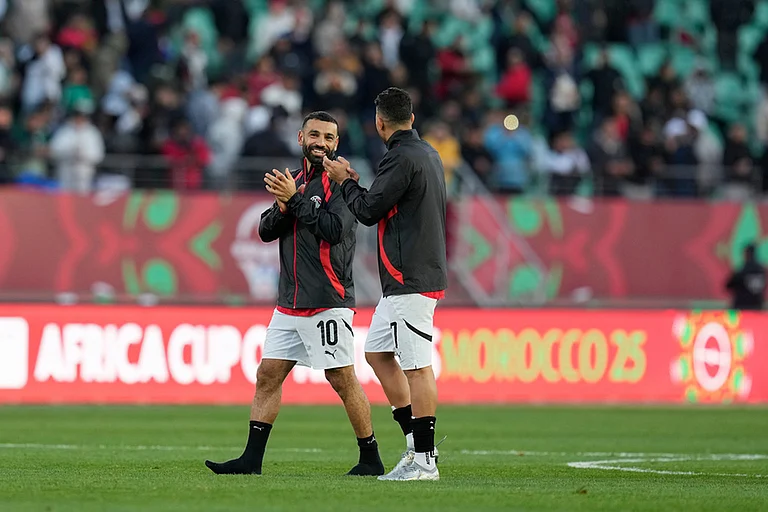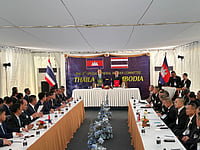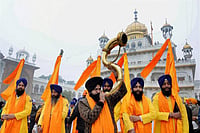The Mistrys do not need to stop experimenting. For the choice of internationalcuisine - in its grand, second coming - available today in Indian cities isimpressive. Consider the menu:
- Japanese
- Lebanese
- Creole
- Spanish
- Vietnamese
The tastes, are they are-a-changing? In Delhi, Syed Sherwani, the fortysomethingowner of Rodeo, the capital’s first Mexican eatery, thinks so. He serves upPollo Loco (chicken in a spicy sauce) and juicy fajitas (flour tortillas servedwith a meat or vegetarian sizzler, sour cream and cheese) to at least 100customers a day at his busy Connaught Place branch.
What’s cooking? For more answers, head southwards to Bangalore and drop in at Dahlia,the city’s only Japanese restaurant. You find Indians squatting on the 15floor-seats and gorging on sushi (thin slices of fresh, raw fish wrapped arounda cake of cooked rice) sashimi (thinly sliced raw fish) and teriyaki (skeweredand broiled marinated slices of meat or shellfish). The few Japanese visitors,like Bangalore-based freelance journalist Taku Kojima, prefer to sit on chairs!It’s a similar scene at the popular Chennai-based Whistle Stop Cafe#, whichcompletes two years in January. It started out with Mediterranean fare for alargely expat clientele. Today, 60 per cent of its babaghanoush and hummus aredevoured by Indians. In Calcutta, a tiny speciality eatery called Taaja, tuckedaway in a sleepy southern neighbourhood, dishes out Cajun dishes, NewOrleans-style, to a packed house; and a curry restaurant introduces afull-fledged Mexican menu. And in the nightlife-deprived northeastern city ofGuwahati, a brave local hotel goes ahead with Mexittachi, an internationalcuisine restaurant serving Mexican, Italian and Thai food. "It’s nice tohave an alternative eatery to dine out at," says Bolin Bordoloi, a teaexecutive, a regular.
Eating out is finally going international in Indian cities. With globalisation camehamburgers and hotdogs, pizza and apple pie, washed down with cola. Now thechoice of the times is authentic global cuisine. It could be Mediterranean - Italian, Spanish, Portuguese, Moroccan,French, Lebanese. Or it could be the brave new world of cuisine from West Asia, Europe, Southeast Asia and Latin America. This time, specialityinternational cuisine has moved out of pricey five-star restaurants to yourdowntown or upscale neighbourhood eatery and swanky chef-ownedupstarts.
Consider this: butter chicken-obsessed Delhi now boasts some 10 international cuisineeateries, cooking up anything from Greek feta salad to Italian gnocchi, fromSpanish paella to Moroccan couscous. There are five Japanese restaurants alonenow, up from three a year ago. Calcutta has nearly a dozen eateries that serve asmorgasbord of international fare: Thai, Malaysian, Cambodian, Vietnamese,Korean and Japanese. Innumerable smaller eateries dotting the city servepasta-based dishes with cheese and tomato-based sauces. Once dowdy andconservative Chennai has a clutch of Italian and Mexican eateries, and threeKorean restaurants alone. Dahlia is one of the hottest food destinations inBangalore. Even small-town eateries are experimenting with a dash of Italian orMexican on their menu. And if that’s not enough, Pune-based Tasty BiteEatables Ltd, manufacturer of ready-to-serve Indian dishes, also plans tointroduce international cuisine in India.
To be sure, the wickedly tasty and greasy great Indian curry still reigns supremeand the ubiquitous Indo-Chinese noodles and chilli chicken continues to set ourtastebuds afire. But flush with disposable incomes, exposed to the world throughcheaper air tickets, cable television and the Internet, the upwardly mobilemiddle-class has seen its culinary aspirations soar in recent years. "We readso much on foreign food and see so much of it on television. Then we want totaste it," says Calcutta-based homemaker-writer Manjira Sarkar.
No wonder Indians are on a serendipitous exploration of international cuisine. Thedemand is clearly rising. Take for example Delhi’s Rodeo: two more branches ofthis Mexican eatery have opened, one in the capital’s satellite city ofGurgaon in Haryana. The diner is the king, he has more than the run-of-the-millchoice between Mughlai and Chinese. Tastes are broadening: steaks, mixed grill,fish and chips, baked fish dishes, Chicken Tetrazzini, Chicken a la Kiev andsuch have always been part of our Continental menus. But now dishes from Greecesuch as the aubergine and minced lamb dish, moussaka, and the Spanish Paela riceare available at a rising number of Indian eateries. "International cuisineisn’t just a fad any longer," says Delhi-based airline executive PiyaliDasgupta, "Indians are now ready toexperiment."
"The attitude to food has changed," says Malini Akerkar, who owns theMumbai-based restaurant Indigo with her husband and head chef, Rahul. "It’sa quest for getting and appreciating good food rather than being seen havingit." The Akerkars first kicked off with Under The Over in 1992 to servereasonably priced pastas and pizzas. They sold the restaurant four years laterand started Indigo in 1999 to whip up raviolis and risotto (Italian cuisine).And in those three years, they found that their clientele had changed."They’ve become far more discerning," says Malini. "At Under-the-Over,they’d put a dollop of ketchup on their pizzas or complain that they didn’tlike a dish without being able to figure out why. At Indigo, there’s noketchup or Tabasco sauce on our tables and our guests very rarely ask for it.And I have people who can tell me that there’s too much rosemary in mychicken."
Clearly,people now know what good food is all about. Is it a fad or the real thing?"It’s the classic chicken-and-egg syndrome," says Rashmi Uday Singh,Mumbai-based food writer. "Did the increased market demand stimulate theexplosion of international eateries or was it the other way around? Possiblythey both happened together." To be sure, the genesis of a lot of theseeateries lies in catering to the burgeoning tribe of homesick expats who set upbase in India with their mnc jobs. Like Sunny’s, Arjun Sajnani and VivekUbhayakar’s ‘New York’ restaurant in Bangalore, where half of theclientele is expat - South Koreans, Americans and Europeans craving for a potatosalad or a filling penne with sausage and peppers.Chennai’s three Koreaneateries essentially cater to the army of expats who arrived in the city afterHyundai Motors opened its automobile factory in Sriperumbudur three years ago.Now Amma Naana, a city departmental store, stocks Asian, American andMediterranean food.
Either way, business is booming for the corner eateries thanks to Indians pouring in tosample the dishes. Olive Bar & Kitchen, Mumbai’s newly openedMediterranean place, is less than a month old. Even though the generous layoutof the restaurant has room for 100 people, you have to book a week in advance totaste some of chef Dev Malik’s dream recipes: Armandrado chicken marinated infresh thyme and almonds (Spanish); black peppercorn-crusted calamari with sweetmarinara sauce and lobster butter drizzle; olive baklava with orange-ginger jus(a Turkish sweet of filo pastry, with lots of nuts and oilseeds, interlayeredwith butter and sugar). "Sometimes we keep the doors closed to restrict peoplecoming in," boasts AD Singh, one of the restaurant’s five owners. Andthey’re still not doing lunch or brunch.
Ditto for the Akerkars’ Indigo, where 150 people, on the average weekday, dine atthe 100-seater restaurant in two sittings; the numbers soaring on weekends. InDelhi too, Wairam Singh Grover’s first attempt at a Lebanese restaurant failedway back in 1992. But now, his Arabian Nites is thriving, not only in upmarketVasant Vihar but also, believe it or not, in troubled Srinagar. The storystarted out a little different for Vicky Singh and chef Meldan D’Cunha’ssizzler and Swiss fondue joint in Mumbai, Out of the Blue. Business was slowinitially but all it took was a couple of favourable press reviews to send outthe word. Once Mumbaikars discovered there was a new restaurant in town, therewas no stopping them. Now the 50-seater restaurant does three dinner rounds onweekends; Singh’s new restaurant, Blue By-U, is opening soon.
If it’s brisk business for restaurateurs, party caterers haven’t beenleft out. Mumbai-based Alwyn Fernandes is having his busiest season. Partyseason, October to February, has at least one bash a day. And he changes hismenu every year to keep his industrialist-clientele "inner circle" happy. Hestarted out with French cuisine, then it was Thai. Now it’s Creole food(cooked with a spicy sauce of tomato, onion and pepper) from the Cajun tribes ofnative Americans, or Lebanese shawarma or Burmese khao suey. His hottest dishes:tomato fondue, the pasta bar with fresh sauces, mussels crumb-fried in anonstick pan, vegetarian Sate, steaks stuffed with lobsters and flamed withcognac.
But traditional tastes die hard. "The typical Indian still wants spice on histongue and goes home disappointed if he doesn’t get it," says Fernandes, whotries to balance his exotic fare with a little good ol’ Indian palak paneerand dal tadka. Other restaurateurs say that international cuisine, thoughincreasingly popular, hasn’t completely shaken off its esoteric airs.Traditional dishes are still needed as signposts to make navigation easier forthe customer, lost between the risotto and the couscous, the tagliatelle and thelinguini.
But the stereotype of the Indian in search of his spices is changing. Okay, Indiansdon’t eat roast, they don’t like their pastas too dry, they like meat withsauce, they relish the spice and the herbs. But they’re still learning to likefood that pushes the boundaries of their conservative palates.Says MaliniAkerkar: "It’s not that Indians want spicy food, they want food they cantaste." So new-age restaurants have sized up the food-savvy Indian gourmet andfigured that he can’t be fooled or underestimated. The new mantra: authenticfood, not Indianised food. True, Chinese food is loved the world over because ofits ability to adapt to the local palate. And to that extent, Chinese cuisineand even possibly Thai have become so popular that they are almost mainstreamnow. But where other international foods are concerned, there’s nopussyfooting around Indian tastebuds. Today, if you give him the ricotta (a kindof cheese) the way it is, he’ll still like it.
"Kill the food at your table if you must," declares Eshmat Khaleeli,co-owner of Chennai’s Whistle Stop Cafe#. "But we won’t do it for you inthe kitchen." Adds Shiromi Anklesaria, chef for Rewind, Mumbai’sHollywood-theme restaurant, which offers a little bit of everything, be itFrench, Italian, Austrian or German, "I keep the food as authentic as possiblebut if a guest wants it more spicy, so be it." Echoes Malik, "As a chef, Ihave to balance authenticity with taste, keeping the general public palate inmind. But I try not to deviate too much from the original recipe." Forexample, Malik’s slow-roasted rosemary lamb in caraway seed (herb) pan gravyis supposed to be sweet. But Indian customers, asserts Malik, want their muttonto be spicy; mutton in sweet sauce would come as too much of a shock. So hetones down the port wine in the sauce.
No wonder Indians are even paying to ‘train’ themselves to eat this food.Fernandes remembers the time when a client begged him to come to Nainital andtrain his factory staff to eat their soup, not slurp it. He politely declined.But Mumbai-based Marilyn Thakur made a business of it. Her Quik ‘N’ Easy classes teach Mumbaikars how to use their cutlery and crockery, how to handle their chopsticks, how to eat‘difficult’ food like spaghetti and snails, to tell a champagne flute from abrandy snifter. Her one-day, three-hour class in table etiquette has about 15people paying Rs 300 each to figure it all out. Each of them gets a typewrittenbooklet of Thakur’s notes and a pair of chopsticks so that they can go homeand practise. "I get people from all classes. Everyone wants to be with it,"says Thakur.
Ambience is important too, because eating international food is also a style statementwith the aspirational middle-class. "People are looking for a casual, trendybut sophisticated place where they can relax - that’s when they really enjoytheir food," says Malini Akerkar. If the eatery owners don’t pay attentionto decor, they could sink fast. It happened to Mumbai’s Hotel President’s ElMexicano eatery, which shut shop this year after bleeding heavily. Its mariachiquintet, its Mexican chef and Mexican hostess, swanky hacienda-like de#cor, itsmargaritas to rave about, couldn’t save it. One of the hotel’s restaurantmanagers, Vishal Singh, had an explanation: "In the US, you have Tex-Mex barsand they’re ultra-casual. But this restaurant had neither the rough, ranchfeel of a Texas bar, nor the spicy tacos and enchiladas that characterisepopular Tex-Mex. The accent here was on authentic Mexican."
The slump in real estate prices and the relative ease of securing finance tostart a restaurant has made it easier for chefs to break out of five-stars and open their own international eateries. Interestingly, many of Mumbai’s hot-shot international eatery owners were trained at five-star hotels or exposed to foreign cuisine while working oncruise liners or at restaurants abroad. Anklesaria, D’Cunha and Fernandes allworked with the Oberoi group. Anklesaria and Malik were on cruise liners for astint; Vicky Singh was educated abroad in hotel management. Fernandes expandedhis repertoire on holidays abroad; learning Thai from the chef to the King ofThailand while in Bangkok, figuring the fondue from a Swiss chef. And Akerkarworked his way from dishwasher to chef at American restaurants.
So gone are the days when the chef was the sweating bawarchi in the kitchen, abeing not to be seen in front of the house.The modern-day, English-speakingstar chef has developed his repertoire over long years of training andexperimentation, his cooking is art. So, Indian condiments and culinarytechniques are often fused, successfully or not, with Western ones. RahulAkerkar’s signature dish: filet of red snapper with potato and basil "poha",artichoke hearts, roasted red pepper and prawn "balchao" with a kokumreduction. "It’s called fusion for want of a better word," avers Akerkarmatter-of-factly. "But as there are more chef-restaurateurs out there, peoplewill be eating more of their unique cuisine."
But there’s still a long way to go before international cuisine specialityrestaurants begin doing roaring business, Hong Kong-style or New York-style. Thequality of food can lack consistency sometimes. It’s also often too expensiveto offer any substantial alternative to the five-star restaurants. Ingredientsaren’t always easy to come by, though that’s changing fast (see box). Andthere’s still the Indian foodie who insists on ketchup with his pizza.
But, make no mistake about it, international cuisine is no longer a fadin India. "Like sports and the performing arts, food, it seems, is one of thebest mediums for international integration," says Calcutta-based food writerNondon Bagchi. No doubt about that. The verdict is clear: Indians nolonger want to be boring curry-fixated wannabe gourmets. Bon apetit!









.png?auto=format%2Ccompress&fit=max&format=webp&w=768&dpr=1.0)








.png?w=200&auto=format%2Ccompress&fit=max)







